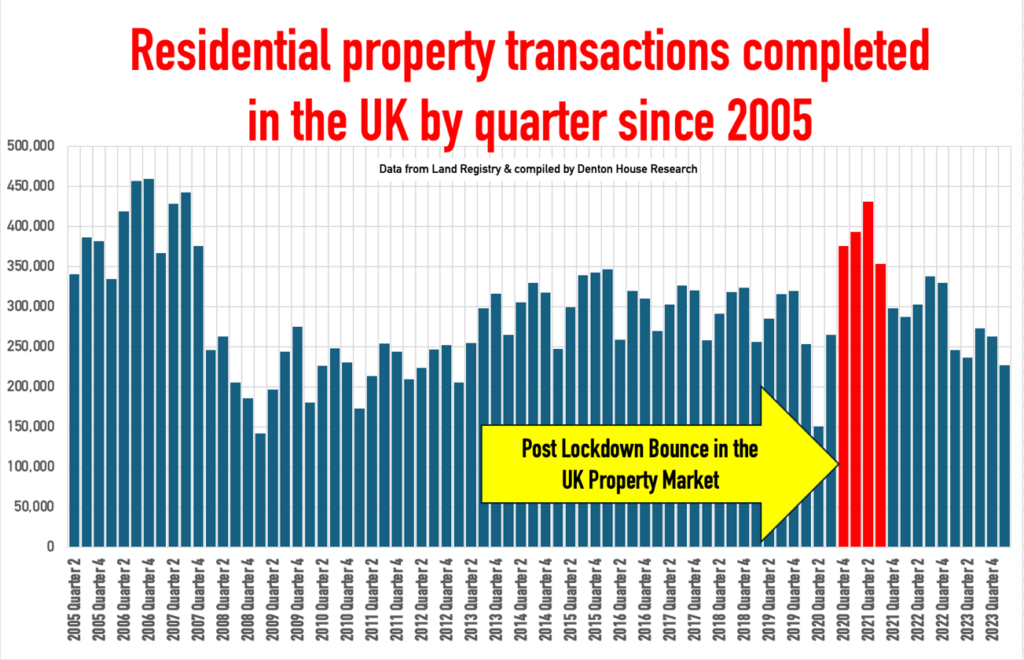
The UK property market has shifted significantly during the pandemic. A notable change is the rise in properties for sale due to ‘buyer’s regret.’ Many homes purchased in 2020 and 2021 are now back on the market.
Currently, 694,281 properties are for sale in the UK, with 8.2% owned by post-lockdown buyers. This article will explore this trend in Lancaster, examining the reasons and implications for the local housing market.
The Post-Lockdown Buying Frenzy in Lancaster
The pandemic has significantly impacted the UK property market. After the first lockdown in spring 2020, remote working became common, prompting many to seek more indoor and outdoor space. This led to a surge in property purchases, especially in suburban and rural areas, as people moved away from inner cities.
For context, the average annual UK home sales since 2005 have been 1,169,864. However, from October 2020 to September 2021, this number jumped to 1,553,860, highlighting the pandemic-induced buying frenzy.

The pandemic dramatically impacted the UK property market. Remote work and the desire for more space led to a surge in property purchases, especially in suburban and rural areas. Low interest rates and government incentives, like the stamp duty holiday, further fueled this buying frenzy.
Traditionally, UK homeowners stay in their properties for many years. In 2023, out of 17.7 million owner-occupied homes, 1.02 million were sold, including 231,000 new homes. This means only 4.48% of existing homeowners moved, averaging a move every 22 years.
In Lancaster, we analyzed 379 properties currently for sale. Of these, 28 were bought during the pandemic (2020/21):
- Semi-detached houses: 8
- Terraced houses: 13
- Apartments: 5
- Bungalows: 2
This raises the question: Is ‘buyer’s regret’ a significant factor in Lancaster’s market?
Why are 8.2% of UK (or 7.4% of Lancaster) homeowners looking to sell so soon after buying?
Several factors could be contributing to this trend:
- Overestimating Suburban/Rural Appeal: Pandemic moves to suburban/rural areas like Lancaster may not have met expectations due to longer commutes, fewer amenities, and a different lifestyle pace.
- Changes in Work Arrangements: As companies call employees back to the office, living in remote areas becomes less practical, prompting moves closer to workplaces.
- Economic Pressures: Rising interest rates make homeownership less affordable, leading some to sell sooner than planned.
- Market Opportunities: Increased property values in Lancaster offer potential profits, encouraging some homeowners to sell.
The unusually high number of properties being sold soon after purchase is increasing the homes available on the market.
- Average properties for sale:
- May 2017: 568,845
- May 2018: 660,019
- May 2019: 667,532
- Three-year average (2017-2019): 632,132
- May 2024: 694,281 properties for sale.

Final Thoughts
The increase in homes for sale means Lancaster sellers must be realistic with their asking prices due to greater competition.
- Realistic Pricing: Since January 2024, only 53 out of every 100 properties listed have been sold, while 47% remain unsold.
- Market Dynamics: The pandemic-driven rush to buy was often based on immediate needs rather than long-term plans, leading to evolving housing preferences as normalcy returns.
This trend highlights the fluidity of the current market. Buyers and sellers in Lancaster should stay informed and adaptable. Follow our agency on social media for more updates and insights.
If you’re considering selling your Lancaster home, let’s chat about your options—no obligation necessary.
Thanks for reading
Michelle x